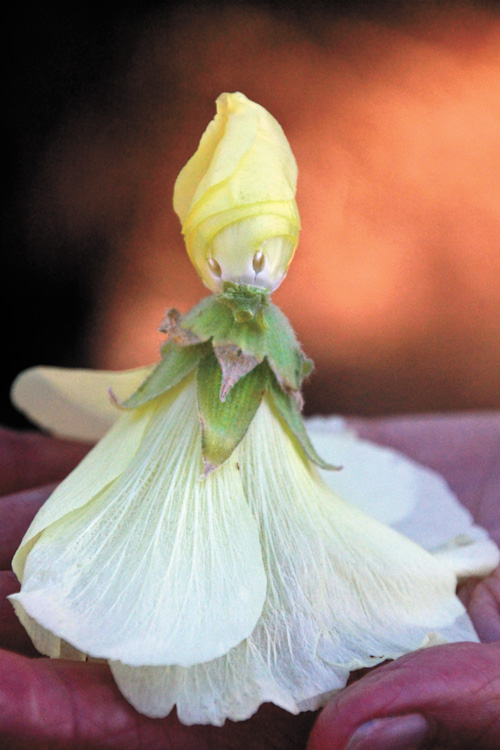How to make a hollyhock lady
April showers bring May flowers … what will late-June showers bring? Are they just washing dust from leaves? Will they help prevent wildfires? Will dormant buds bloom? Will annual grass seeds sprout? This will bear watching. There were almost two inches of rain in my rain gauge!
As a little kid in Massachusetts, I used to love wandering in my mother’s and my grandmother’s perennial gardens. They grew all the standard flowers: Peonies, roses, foxgloves, columbines, phlox, iris, hostas, violets, day lilies, lilies-of-the-valley, daisies, black-eyed Susans, hollyhocks and more. At some point, my mother taught me to make a Hollyhock Lady, as her mother had taught her. I now make one for my granddaughter.
Let me tell you how: Pick an open bloom and a bud with some petals showing. Leave about a quarter-inch of stem on the bloom. Peel off the green from the bud to expose the white base, which has little holes (these become the Lady’s eyes) in it. Insert the stem of the bloom into one of the holes: you now have a beautiful Hollyhock Lady!
Last month I wrote of the panic I went through upon finding mealybugs on all the Howard McMinn manzanitas (Arctostaphylos ‘Howard McMinn’) in my yard. I bought a Safer product to spray on each little white cottony cluster and put out ant traps at the base of each shrub, as they were carrying the bugs up the stems.
I squished and squashed the bugs as I could and cleared away all the debris at the base, finding many cottony nests as I did. I eliminated all surrounding plants that were compromising the shrubs and opened them all up to more sun and air. I am happy to report that all the bugs are gone!
In the meantime, I have learned from Phil VanSoelen, a manzanita expert, how to prune them to expose their shiny red trunks to most advantage, thus giving them the air and sun they need to thrive. The idea is to trim off all the little dead twigs and branches and eliminate the branches that are heading vertically across the plant and in the center. Shake each branch vigorously to knock off the dead leaves. Many manzanita leaves turn brown in the summer; this is a survival mechanism, a way to cope with drought. Then make certain the base of the shrubs is open and clear of debris and mulch. You should end up with pretty, open, healthy manzanitas.
There are no CNPS meetings in July or August; they will begin again in September. Note on your October calendar the CNPS Native Plant Sale in Santa Rosa at the Vets Memorial Building, 9 a.m. to 1 p.m., Saturday, Oct. 12, 2013.
The Occidental Arts & Ecology Center is holding a July 27 tour of their gardens. Tour starts at 10 a.m. and lasts about two hours. Their tours are fun, fascinating, and a good learning experience.
Have a happy, restful July:
jo*******@co*****.net
.
49.5
F
Healdsburg
November 17, 2024








